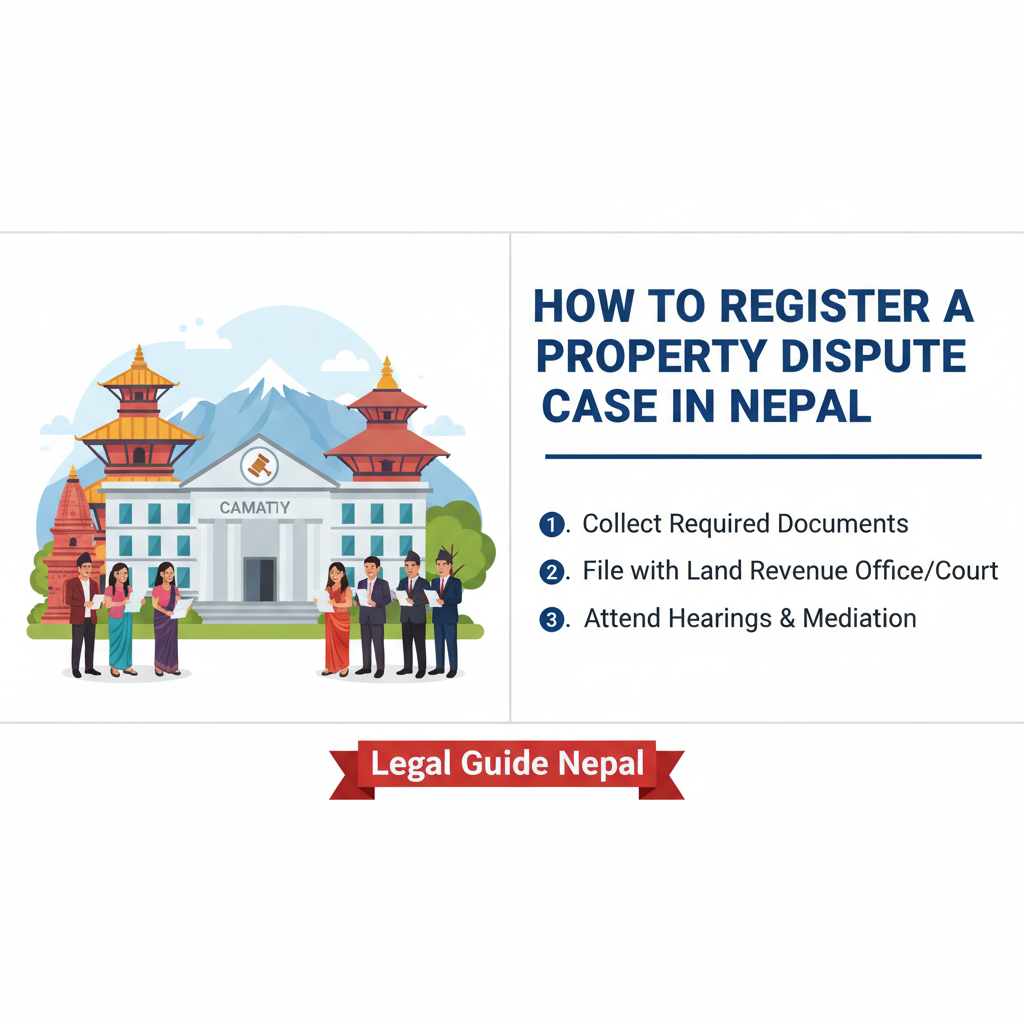
Property disputes are among the most stressful and complex legal challenges a person can face in Nepal. Whether it’s a disagreement over a boundary line, an ownership claim, or an inheritance issue, navigating the legal landscape can feel overwhelming. The thought of court proceedings, endless paperwork, and complex legal jargon can be paralyzing.
But you don’t have to navigate this alone. This comprehensive guide is designed specifically for property owners like you. We will break down the entire property dispute case registration in Nepal into clear, manageable steps. Our goal is to demystify the process, provide you with actionable information, and empower you to take the next step with confidence. As experts in Nepalese property law, we’ve helped countless individuals protect their rights and secure their assets.
Understanding Common Property Disputes in Nepal
Before diving into the registration process, it’s helpful to understand the common types of disputes that arise. Knowing your specific issue can help you prepare better. The most frequent cases involve:
- Boundary Disputes: Conflicts over the exact lines separating two properties.
- Ownership Claims: Challenges to the legal ownership of a property, often based on inheritance, sales, or gifts.
- Inheritance Issues: Disagreements among heirs over the division of ancestral property.
- Encroachment: When a neighbor illegally builds on or uses a portion of your property.
- Tenancy and Landlord Disputes: Conflicts arising from rental agreements, especially concerning property use or eviction.
If you’re facing any of these issues, understanding the land dispute filing process is your first critical move toward a resolution.
The Complete Step-by-Step Guide to Property Dispute Case Registration in Nepal
Filing a case requires meticulous attention to detail. A single misstep can lead to delays or even dismissal. Follow these steps precisely to ensure your case is registered correctly.
Step 1: Initial Assessment – Does Your Case Qualify?
Not every disagreement warrants a court case. Before proceeding, you must have a legitimate legal claim. This means you must have suffered a legal wrong, and you must have the right to seek a legal remedy. Ask yourself:
- Do I have legal documents (like a land ownership certificate) to support my claim?
- Have I been directly harmed by the other party’s actions?
- Is there a clear legal principle that supports my position?
Consulting with a property dispute lawyer in Nepal at this early stage can save you significant time and money by helping you assess the strength of your case.
Step 2: Pre-Litigation Requirements – Attempting Mediation
Nepalese law, particularly the Civil Procedure Code, encourages parties to resolve disputes outside of court. Before filing a lawsuit, you may be required to show that you attempted mediation.
- Document Your Attempts: Keep records of any meetings, letters, or communications where you tried to settle the dispute amicably.
- Formal Mediation: In some cases, a formal mediation session through a local body or a recognized mediator might be necessary. The records from this session are crucial if the case proceeds to court.
Failing to demonstrate a genuine attempt at resolution can negatively impact your case later on.
Step 3: Identifying the Correct Court – Jurisdiction Matters
You cannot file your case just anywhere. It must be filed in a court that has the authority to hear it. This is known as jurisdiction. For property cases, jurisdiction is typically determined by:
- Location: The case must be filed in the court where the property is located. For example, a dispute over land in Kathmandu must be filed in a court within the Kathmandu district.
- Value of the Property: The monetary value of the disputed property determines the level of court.
- District Court: Handles most property cases, regardless of value, as the court of first instance.
- High Court: Hears appeals from the District Court.
- Supreme Court: The final court of appeal.
For a new case, you will almost always be filing at the relevant District Court. This is a critical part of the property case court Nepal system.
Step 4: Preparing the Case File – Organizing Your Evidence
This is the foundation of your case. A well-organized case file not only impresses the court but also makes your lawyer’s job easier. Start gathering and organizing every piece of evidence you have. This includes all the documents listed in the next section. Create copies of everything and organize them chronologically or by type.
Step 5: Drafting the Petition (Writ of Summons) – The Core of Your Case
The petition, also known as a “Writ of Summons,” is the formal legal document that initiates the lawsuit. While it’s highly recommended to have a lawyer draft this, understanding its components is vital. A petition must include:
- Title: The name of the court.
- Case Number: Left blank for the court to fill in.
- Parties: Full names, addresses, and details of the plaintiff (you) and the defendant (the opposing party).
- Facts of the Case: A chronological, factual account of what happened. Be clear, concise, and stick to the facts.
- Grounds for the Case: The legal basis for your claim. This section connects the facts to specific laws.
- Prayer/Relief Sought: A clear statement of what you want the court to do (e.g., “declare the plaintiff as the rightful owner,” “issue an injunction to stop construction,” etc.).
- Verification: A statement signed by you, affirming that the facts in the petition are true to the best of your knowledge.
- List of Documents: An index of all the documents you are submitting as evidence.
Step 6: Filing Procedures – Submitting Your Case
Once your petition and all supporting documents are ready, it’s time to file them.
- Where to File: Go to the registry section of the appropriate District Court.
- How to Submit: Submit the original petition along with the required number of copies (usually one for the court and one for each defendant) and all supporting documents.
- Whom to Contact: The court clerk or registry officer will guide you on the exact submission process. Be polite and professional.
Step 7: Payment of Court Fees – The Financial Step
Filing a case requires paying a government-mandated court fee. This fee is based on the value of the property in dispute.
- Fee Structure: The court will have a schedule of fees. Your lawyer can help you calculate the exact amount.
- Payment Method: Fees are typically paid at a designated bank counter within the court premises or via a bank voucher.
- Receipt: Crucially, you must obtain and keep the payment receipt. This receipt is proof of payment and must be attached to your case file.
Step 8: Case Number Assignment and Acknowledgment Receipt
After reviewing your petition and documents for completeness, the court registry will:
- Assign a unique case number to your lawsuit.
- Stamp the petition with the official seal and date of registration.
- Provide you with an acknowledgment receipt.
This receipt is your proof that the case has been officially registered. It will contain the case number, the date of filing, and the name of the judge assigned to your case. Safeguard this document.
Step 9: Service of Notice to the Opposing Party
The court does not automatically inform the defendant. You or your lawyer must ensure they receive a formal notice of the lawsuit.
- Process: The court will issue summons notices. These must be formally served on the defendant(s).
- Proof of Service: The person serving the notice must provide a “proof of service” document to the court, confirming that the defendant has received it. This is a critical step before the case can proceed.
Step 10: Initial Hearing Date and What to Expect
Once the defendant has been served, the court will schedule the first hearing.
- Scheduling: The date will be communicated to both parties.
- Purpose of the First Hearing: The judge will typically use this hearing to confirm that both parties have received notice, to clarify the main issues in the dispute, and to give the defendant an opportunity to file their written response (a “written reply” or “defense”).
- Your Presence: You and your lawyer must be present on this date.
Step 11: Post-Filing Procedures and Next Steps
After the initial hearing, the real real estate litigation Nepal process begins. The court will set a schedule for submitting further evidence, witness examinations, and arguments. This phase can be lengthy, and having a skilled lawyer is indispensable for navigating the procedural complexities.
Essential Documentation Checklist for Filing a Property Case in Nepal
Incomplete documentation is the most common reason for case rejection or delays. Use this comprehensive checklist to prepare your file. Ensure you have both the originals and attested photocopies.
- Property Ownership Documents: This is the most critical piece of evidence. It can be a Land Registration Certificate (Lal Purja), Sale Deed, Gift Deed, or any other document proving your title.
- Citizenship Certificates: Copies of the citizenship certificates of all parties involved (plaintiff and defendant).
- Tax Clearance Certificates: A recent tax clearance certificate from the Land Revenue Office, proving that all property taxes have been paid up to date.
- Property Valuation Documents: An official valuation report from a recognized valuer or the Land Revenue Office can be crucial, especially for determining court fees and the stakes of the dispute.
- Survey Maps and Boundary Documents: If available, include official survey maps (Napi Naksha) and any documents that clearly define the property’s boundaries.
- Photographs and Physical Evidence: Clear, dated photographs of the property, the disputed area, any encroachments, or relevant physical conditions.
- Witness Statements and Affidavits: Written statements from individuals who have firsthand knowledge of the dispute or the property’s history. These should be sworn affidavits.
- Previous Correspondence: Any letters, emails, or legal notices you have sent or received related to the dispute.
- Mediation Attempt Records: As mentioned in Step 2, any documentation proving you attempted to settle the matter out of court.
- Power of Attorney: If you have hired a lawyer to represent you, you must provide them with a notarized Power of Attorney.
- Court Fee Payment Receipt: The original receipt from Step 7.
- Inheritance Documents (if applicable): If the dispute is over ancestral property, include wills, succession certificates, or documents proving your relationship to the deceased owner.
- Family Tree (if applicable): For inheritance cases, a clear family tree can help the court understand the relationships between all potential heirs.
Key Considerations and Common Pitfalls to Avoid
Even with a step-by-step guide, certain aspects of the process require extra attention.
The Role of Government Bodies
The Land Revenue Office is a key player. It holds the official records of all property transactions. Information obtained from here is often considered definitive proof. Local municipal authorities may also be involved, especially in disputes related to construction or land use.
Legal Representation: When to Hire a Lawyer
While you have the right to represent yourself, property law is notoriously complex. A single procedural error can be fatal to your case. Hiring an experienced property dispute lawyer Nepal is not just a recommendation; it’s a necessity for ensuring your rights are protected. A lawyer will handle drafting, filing, and courtroom advocacy, allowing you to focus on your life.
Common Mistakes Property Owners Make
- Filing in the wrong jurisdiction.
- Submitting incomplete or improperly formatted documents.
- Failing to pay the correct court fee.
- Ignoring the importance of pre-litigation mediation.
- Waiting too long to file, risking the statute of limitations.
Costs Involved
Beyond the court fee, be prepared for other costs:
- Lawyer’s Fees: Can be a flat fee or a percentage of the property value.
- Valuation Fees: For official property valuation reports.
- Miscellaneous Costs: Photocopying, travel, notary fees, etc.
Timeline Expectations
Be patient. The Nepalese judicial system is often overburdened. A simple property dispute can take several years to reach a final conclusion, especially if it is appealed. The initial registration process itself might take a few weeks to a month.
Frequently Asked Questions (FAQ)
Q1: How long does the entire property dispute case registration process take?
A1: The initial registration—from preparing the petition to getting a case number—can take anywhere from a few days to a couple of weeks, depending on the court’s workload and the completeness of your documentation.
Q2: Can I file a property dispute case in Nepal without a lawyer?
A2: Legally, yes. However, it is extremely risky. The procedural requirements are strict, and the opposing party will likely have legal representation. Without a lawyer, you are at a significant disadvantage.
Q3: What is the most common reason a property case gets rejected by the court?
A3: The most common reason is the submission of incomplete or incorrect documentation. This is followed closely by filing in a court that lacks proper jurisdiction.
Protect Your Property Rights with Expert Legal Guidance
Navigating a property dispute is a challenging journey, but you don’t have to walk it alone. Understanding the property dispute case registration in Nepal is the first step, but having a dedicated legal expert by your side is what will ultimately protect your investment and secure your peace of mind.
Our team of seasoned property lawyers specializes in property dispute documents Nepal and the entire litigation process. We have a proven track record of successfully representing clients in Kathmandu and across major cities in Nepal.
Don’t wait for the dispute to escalate. Contact us today for a confidential consultation and let us be your trusted partner in safeguarding your property rights.



